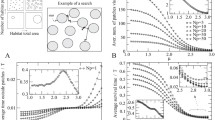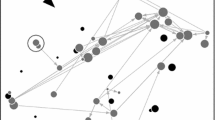Abstract
Most ecological and evolutionary processes are thought to critically depend on dispersal and individual movement but there is little empirical information on the movement strategies used by animals to find resources. In particular, it is unclear whether behavioural variation exists at all scales, or whether behavioural decisions are primarily made at small spatial scales and thus broad-scale patterns of movement simply reflect underlying resource distributions. We evaluated animal movement responses to variable resource distributions using the grey teal (Anas gracilis) in agricultural and desert landscapes in Australia as a model system. Birds in the two landscapes differed in the fractal dimension of their movement paths, with teal in the desert landscape moving less tortuously overall than their counterparts in the agricultural landscape. However, the most striking result was the high levels of individual variability in movement strategies, with different animals exhibiting different responses to the same resources. Teal in the agricultural basin moved with both high and low tortuosity, while teal in the desert basin primarily moved using low levels of tortuosity. These results call into question the idea that broad-scale movement patterns simply reflect underlying resource distributions, and suggest that movement responses in some animals may be behaviourally complex regardless of the spatial scale over which movement occurs.







Similar content being viewed by others
References
Argos CLS (1996) User’s manual, Manual de l’utilisateur. Argos, Toulouse
Atkinson RPD, Rhodes CJ, Macdonald DW, Anderson RM (2002) Scale-free dynamics in the movement patterns of jackals. Oikos 98:134–140
Bartumeus F, Catalan J, Fulco UL, Lyra ML, Viswanathan GM (2002) Optimizing the encounter rate in biological interactions: Lévy versus Brownian strategies. Phys Rev Lett 88: article no. 097901
Bélisle M (2005) Measuring landscape connectivity: the challenge of behavioural landscape ecology. Ecology 86:1988–1995
Benhamou S, Bried J, Bonadonna F, Jouventin P (2003) Homing in pelagic birds: a pilot experiment with white-chinned petrels released in the open sea. Behav Processes 61:95–100
Bennetts RE, Kitchens WM (2000) Factors influencing movement probabilities of a nomadic food specialist: proximate foraging benefits or ultimate gains from exploration? Oikos 91:459–467
Bingman VP, Able KP (2002) Maps in birds: representational mechanisms and neural bases. Curr Opin Neurobiol 12:745–750
Bunn SE, Davies PM, Winning M (2003) Sources of organic carbon supporting the food web of an arid zone floodplain river. Freshwater Biol 48:619–635
Cantwell MD, Forman RTT (1993) Landscape graphs—ecological modeling with graph theory to detect configurations common to diverse landscapes. Landscape Ecol 8:239–255
Conradt L, Zollner PA, Roper TJ, Frank K, Thomas CD (2003) Foray search: an effective systematic dispersal strategy in fragmented landscapes. Am Nat 161:905–915
Dicke M, Burrough PA (1988) Using fractal dimensions for characterizing tortuosity of animal trails. Physiol Entomol 13:393–398
Doerr ED, Doerr VAJ (2005) Dispersal range analysis: quantifying individual variation in dispersal behaviour. Oecologia 142:1–10
Doerr VAJ, Doerr ED (2004) Fractal analysis can explain individual variation in dispersal search paths. Ecology 85:1428–1438
Environment Australia (2001) A Directory of important wetlands in Australia, 3rd edn. Environment Australia, Canberra
Fauchald P (1999) Foraging in a hierarchical patch system. Am Nat 153:603–613
Fauchald P, Erikstad KE, Skarsfjord H (2000) Scale-dependent predator-prey interactions: the hierarchical spatial distribution of seabirds and prey. Ecology 81:773–783
Fauchald P, Tveraa T (2006) Hierarchical patch dynamics and animal movement. Oecologia 149:383–395
Frith HJ (1957) Breeding and movements of wild ducks in inland New South Wales. CSIRO Wildl Res 2:19–31
Frith HJ (1959) The ecology of wild ducks in inland New South Wales. II. Movements. CSIRO Wildl Res 4:108–130
Frith HJ (1963) Movements and mortality rates of the black duck and grey teal in south-eastern Australia. CSIRO Wildl Res 8:119–131
Frith HJ (1982) Waterfowl in Australia, 2nd edn. Angus & Robertson, Sydney
Fritz H, Said S, Weimerskirch H (2003) Scale-dependent hierarchical adjustments of movement patterns in a long-range foraging seabird. Proc R Soc Lond Ser B Biol Sci 270:1143–1148
Fullaghar PJ (1992) The taxonomic and conservation status of the Indonesian teal Anas gibberifrons. IWRB Threat Waterfowl Res Group Newslett 2:7–8
Green DG (1994) Connectivity and complexity in landscapes and ecosystems. Pac Conserv Biol 1:194–200
Hutchings MJ, John EA, Stewart AJA (2000) The ecological consequences of environmental heterogeneity: the 40th symposium of the British Ecological Society. Blackwell Science, Malden, MA
Janson CH, Byrne R (2007) What wild primates know about resources: opening up the black box. Anim Cogn 10:357–367
Keitt TH, Urban DL, Milne BT (1997) Detecting critical scales in fragmented landscapes. Conserv Ecol 1:4
Kenow KP, Meyer MW, Evers DC, Douglas DC, Hines J (2002) Use of satellite telemetry to identify common loon migration routes, staging areas and wintering range. Waterbirds 25:449–458
Kear J, Hulme M (2005) Ducks, geese and swans. Oxford University Press, Oxford
Kingsford RT (2000) Ecological impacts of dams, water diversions management on floodplain wetlands in Australia. Austral Ecol 25:109–127
Klaassen RHG, Nolet BA, Van Leeuwen CHA (2007) Prior knowledge about spatial pattern affects patch assessment rather than movement between patches in tactile-feeding mallard. J Anim Ecol 76:20–29
Knighton AD, Nanson GC (1994) Flow transmission along an arid zone anastomosing river, Cooper Creek, Australia. Hydrol Processes 8:137–154
Kolasa J, Pickett STA (eds) (1991) Ecological heterogeneity. Springer, New York
Kotwicki V (1986) Floods of Lake Eyre. South Australian Government, Adelaide
Levene H (1960) Robust tests for equality of variances. In: Olkin I, Ghurye SG, Hoeffding W, Madow WG, Mann HB (Eds) Contributions to probability and statistics. Stanford University Press, Stanford, pp 278–292
Lima SL, Zollner PA (1996) Towards a behavioural ecology of ecological landscapes. Trends Ecol Evol 11:131–135
Lipp HP, Vyssotski AL, Wolfer DP, Renaudineau S, Savini M, Troster G, Dell’omo G (2004) Pigeon homing along highways and exits. Curr Biol 14:1239–1249
Mandelbrot BB (1967) How long is the coast of Britain? Statistical self-similarity and fractional dimension. Science 156:636–638
Manly BFJ (1995) Randomization tests to compare means with unequal variation. Sankhya: Indian J Stat 57:200–222
Manly BFJ, Francis RICC (1999) Analysis of variance by randomization when variances are unequal. Aust N Z J Stat 41:411–429
Marchant S, Higgins PJ (1990) Handbook of Australian, New Zealand and Antarctic birds. Volume 1. Ratites to ducks. Oxford University Press, Melbourne
Marzluff JM, Millspaugh JJ, Hurvitz P, Handcock MS (2004) Relating resources to a probabilistic measure of space use: forest fragments and Stellar’s Jay. Ecology 85:1411–1427
Mårell A, Ball JP, Hofgaard A (2002) Foraging and movement trajectories of female reindeer: insights from fractal analysis, correlated random walks and Lévy flights. Can J Zool 80:854–865
McFeeters SK (1996) The use of the normalized difference water index (NDWI) in the delineation of open water features. Int J Remote Sens 17:1425–1432
Miller MR, Takekawa JY, Fleskes JP, Orthmeyer DL, Casazza ML, Perry WM (2005). Spring migration of northern pintails from California’s Central Valley wintering area tracked with satellite telemetry: routes, timing, and destinations. Can J Zool 83:1314–1332
Mitchell MS, Powell RA (2004) A mechanistic home range model of optimal use of spatially distributed resources. Ecol Modell 177:209–232
Mitchell MS, Powell RA (2007) Optimal use of resources structures home ranges and spatial distribution of black bears. Anim Behav 74:219–230
Nams VO (2005) Using animal movement paths to measure response to spatial scale. Oecologia 143:179–188
Nams VO, Bourgeois M (2004) Fractal analysis measures habitat use at different spatial scales: an example with American marten. Can J Zool 82:1738–1747
Noser R, Byrne RW (2007a) Mental maps in Chacma baboons (Papio ursinus): using inter-group encounters as a natural experiment. Anim Cogn 10:331–340
Noser R, Byrne RW (2007b) Travel routes and planning of visits to out-of-sight resources in wild Chacma baboons (Papio ursinus). Anim Behav 73:257–266
Puckridge JT (1998) Wetland management in arid Australia. The Lake Eyre Basin as an example. In: Williams WD (ed) Wetlands in a dry land: understanding for management. Environment Australia, Canberra, pp 87–96
Roshier DA, Rumbachs RM (2004) Broad-scale mapping of temporary wetlands in arid Australia. J Arid Environ 56:249–263
Roshier DA, Robertson AI, Kingsford RT, Green DG (2001a) Continental-scale interactions with temporary resources may explain the paradox of large populations of desert waterbirds in australia. Landsc Ecol 16:547–556
Roshier DA, Whetton PH, Allan RJ, Robertson AI (2001b) Distribution and persistence of temporary wetland habitats in arid Australia in relation to climate. Austral Ecol 26:371–384
Roshier DA, Klomp NI, Asmus MW (2006) Movements of a nomadic waterfowl, grey teal Anas gracilis, across inland Australia—results from satellite telemetry spanning 15 months. Ardea 94(3) (in press)
Roshier DA, Asmus MW, Klaassen M (2008) What drives long-distance movements in the nomadic grey teal Anas gracilis in Australia? Ibis (in press)
Sheldon F, Boulton AJ, Puckridge JT (2002) Conservation value of variable connectivity: aquatic invertebrate assemblages of channel and floodplain habitats of a central Australian arid-zone river, cooper creek. Biol Conserv 103:13–31
Sheppard JK, Preen AR, Marsh H, Lawler IR, Whiting SD, Jones RE (2006) Movement heterogeneity of dugongs, Dugong dugon (Müller), over large spatial scales. J Exp Mar Biol Ecol 334:64–83
Sugihara G, May RM (1990) Applications for fractals in ecology. Trends Ecol Evol 5:79–86
Taylor PD, Fahrig L, Henein K, Merriam G (1993) Connectivity is a vital element of landscape structure. Oikos 68:571–573
Turchin P (1996) Fractal analyses of animal movement: a critique. Ecology 77:2086–2090
Turchin P (1998) Quantitative analysis of movement. Sinauer, Sutherland
Urban D, Keitt T (2001) landscape connectivity: a graph-theoretic perspective. Ecology 82:1205–1218
Van Valen L (1978) The statistics of variation. Evol Theory 4:33–43
Verdin JP (1996) Remote sensing of ephemeral water bodies in western Niger. Int J Remote Sens 17:733–748
Viswanathan GM, Afanasyev V, Buldyrev SV, Havlin S, Da Luz MGE, Raposo EP, Stanley HE (2000) Lévy flights in random searches. Physica A 282:1–12
Viswanathan GM, Bartumeus F, Buldyrev SV, Catalan J, Fulco UL, Havlin S, Da Luz MGE, Lyra ML, Raposo EP, Stanley HE (2002) Lévy flight random searches in biological phenomena. Physica A 314:208–213
Viswanathan GM, Buldyrev SV, Havlin S, Da Luz MGE, Raposo EP, Stanley HE (1999) Optimizing the success of random searches. Nature 401:911–914
Viswanathan GM, Afanasyev V, Buldyrev SV, Murphy EJ, Prince PA, Stanley HE (1996) Lévy flight search patterns of wandering albatrosses. Nature 381:413–415
Weins JA (1989) Spatial scaling in ecology. Funct Ecol 3:385–397
Weins JA, Milne BT (1989) Scaling of ‘landscapes’ in landscape ecology, or, landscape ecology from a beetle’s perspective. Landscape Ecol 3:87–96
Westcott DA, Graham DL (2000) Patterns of movement and seed dispersal of a tropical frugivore. Oecologia 122:249–257
Young HG, Sorenson MD, Johnson KP (1997) A description of the Madagascar teal Anas bernieri and an examination of its relationships with the grey teal A. gracilis. Wildfowl 48:174–180
Zollner PA, Lima SL (1999) Search strategies for landscape-level interpatch movements. Ecology 80:1019–1030
Zollner PA, Lima SL (2005) Behavioral tradeoffs when dispersing across a patchy landscape. Oikos 108:219–230
Acknowledgements
We gratefully acknowledge Mike Schultz for his time and invaluable knowledge of waterbirds, Martin Asmus and Mark Wilson for their able assistance in the field, Craig Poynter for drawing the maps and the Fivebough and Tuckerbill Wetlands Management Trust. Leo Joseph, David Watson and two anonymous reviewers provided helpful comments to improve the manuscript. This project was undertaken under NSW National Parks and Wildlife Scientific Licence numbers S10426 and 3244 and Charles Sturt University Animal Care and Ethics Approval No. 01/061. We gratefully acknowledge the funding of this project by the New South Wales National Parks and Wildlife Service, Rural Industries Research and Development Corporation UCS34A and the Australian Research Council LP0347040.
Author information
Authors and Affiliations
Corresponding author
Additional information
Communicated by Wolf Mooij.
Rights and permissions
About this article
Cite this article
Roshier, D.A., Doerr, V.A.J. & Doerr, E.D. Animal movement in dynamic landscapes: interaction between behavioural strategies and resource distributions. Oecologia 156, 465–477 (2008). https://doi.org/10.1007/s00442-008-0987-0
Received:
Accepted:
Published:
Issue Date:
DOI: https://doi.org/10.1007/s00442-008-0987-0




